Psilogramma menephron
(Cramer, 1780)

Psilogramma menephron
This site has been created by Bill Oehlke.
Comments, suggestions and/or additional information are welcomed by
Bill.
Images and information on this page are from
Don Herbison-Evans (Australia).
TAXONOMY:
Family: Sphingidae, Latreille, 1802
Subfamily: Sphinginae, Latreille, [1802]
Tribe: Sphingini, Latreille, 1802
Genus: Psilogramma ...........
Species: menephron (Cramer, 1780)
|
DISTRIBUTION:
The Gray Hawk Moth or Privet Hawk Moth, Psilogramma menephron (Wingspan: 82--138mm.),
flies in Hawaii, and has an extended range across the Pacific Ocean to Australia, Hong Kong, and
the Philippines.
The adult moth has long narrow wings which are a grey-brown colour,
with a darker, wavy pattern. The abdomen is grey with a dark dorsal line. The moth typically rests with the tip of the abdomen
curled under the body. The male can make a hissing sound by rubbing parts of its body together. | 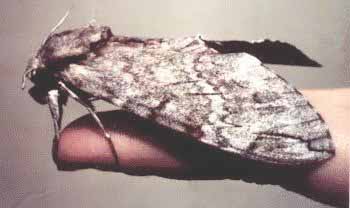
|
FLIGHT TIMES: Psilogramma menephron adults probably fly from April to July, but that is just a guess.
ECLOSION:When the Caterpillar is fully grown, it leaves the food plant and walks up to 20 metres to pupate under the surface
debris of loose soil and leaves. Emergence or eclosion is from the ground surface under the leaf litter.
SCENTING AND MATING:Females call in the males with a pheromone released from a gland at the tip of the
abdomen. Adults take nectar from flowers.
|  |
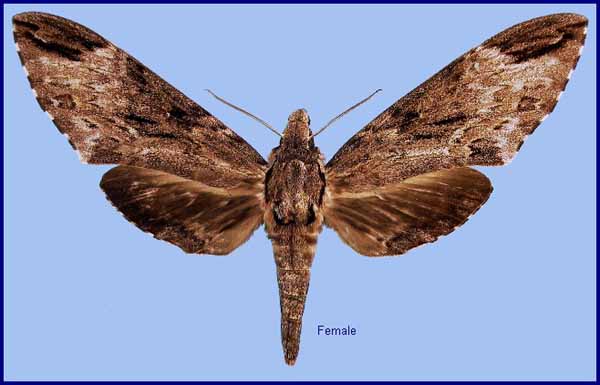
EGGS, LARVAE, PUPAE:
Eggs are pale green, slightly ovoid (1.4 x 1.6mm), smooth and shiny.
The Caterpillar is an agricultural pest on Olive trees (Olea europaea, OLEACEAE),
but is perhaps most often found in suburbia on Privet (Ligustrum vulgare, OLEACEAE ),
Jasmine (Jasminum officinale, OLEACEAE ), and Australian Native Olive (Olea paniculata, OLEACEAE),
but also feeds on other plants in the families: OLEACEAE and BIGNONIACEAE.
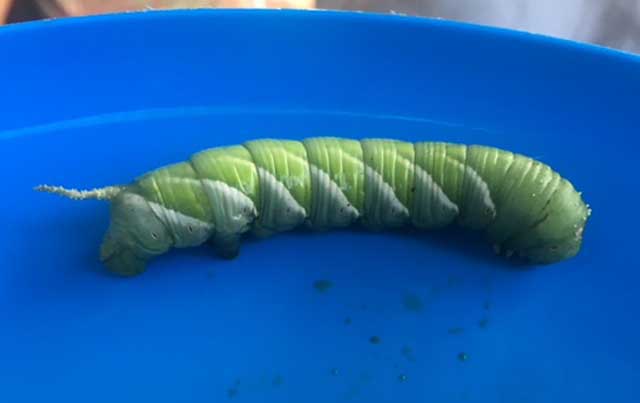
Psilogramma menephron, final instar, Kailua, Hawaii,
August 16, 2018, courtesy of David and Jason Kristi Balstad.

Psilogramma menephron, Waikoloa, Hawaii, January 7, 2007,
courtesy of Michael F. O'Brien
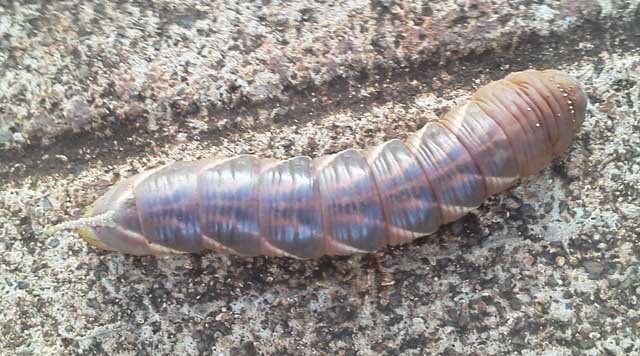
Psilogramma menephron prepupal fifth instar, Kapolei, Hawaii,
December 31, 2012, Leslie and Samuel Rush, via Justin Rush, tentative id by Bill Oehlke.

Psilogramma menephron, pre-pupal colour change, Oahu, Hawaii,
November 13, 2021, courtesy of Dixon Smith.
The granulose, bluish-white anal horn was most helpful in identifying the larva depicted immediately above.
Many Sphingidae larvae will darken (reddish brown to brown) considerably when they are ready to pupate, especially if they are going into a diapausing state.
I suspect this larva from the Rush family is geared to overwinter, and under natural conditions, probably would not emerge until spring (April, guess).
For care of "found larvae/caterpillars" visit Manduca sexta August 21, 2008, Trina Woodall.
This Caterpillar is green with a strong curved Bluish-white horn on its tail pointing backwards, and a series of
diagonal white stripes on its sides.
The coloration of the Caterpillar looks very striking, but when the Caterpillar is on a Privet bush, the spacing of the stripes is about
the same as that of the leaves, and the Caterpillar becomes very hard to see. This use of colour to hide is a form of camouflage called
disruptive coloration. The Caterpillar is most easily located by observing the black fecal pellets under the bush where it is feeding.
When disturbed, the Caterpillar lifts the front of its body, and bends its head underneath, exposing a series of white warts on its
shoulders. It grows to a length of about 90--110mm and has both green and brown forms. | 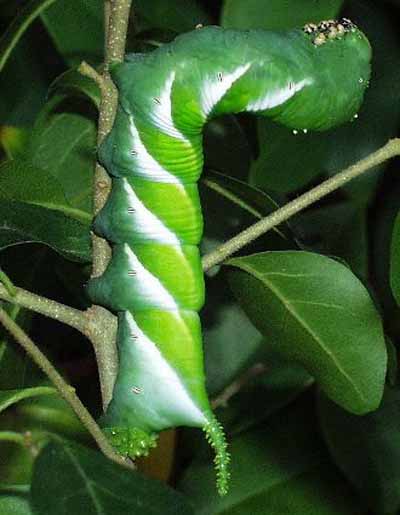
|
Larval hosts include the following: Campsis, Clytostoma, Dolichandrone, Oroxylum, Pandorea, Podranea,
Spathodea, Tecome (Bignoniaceae); Buxus (Buxaceae); Lonicera, Viburnum (Caprifoliaceae); Casuarina (Casuarinaceae); Pangium
(Flacourtiaceae); Perilla (Labiatae); Melia (Meliaceae); Fraxinus, Jasminum, Ligustrum, Notelaea, Nyctanthes, Olea, Osmanthus, Syringa (Oleaceae); Sesamum
(Pedaliaceae); Antirrhinum, Paulownia, Hebe (Scrophulariaceae); Callicarpa, Clerodendrum, Gmelina, Tectona, Vitex (Verbenaceae).
The pupa, (48--60mm long) like that of many Hawk Moths, has a separate compartment at one end in which the haustellum develops.Pupation is
under leaf litter and loose soil at ground surface. |

|
Sphingidae of Hawaii
Return to U. S. A. Table
Return to Sphingidae Index
Return to Macroglossini Tribe









